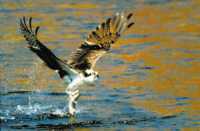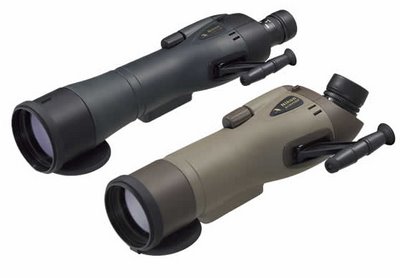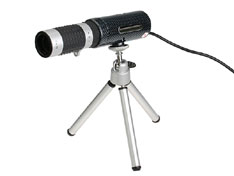Q & A with an astronomer

Well...did you ever wonder how a planetarium coordinator thinks? I just knew it! Here's the juicy
detail:
...
Choosing astronomy: "I'm not exactly sure how I latched onto the idea (in fourth grade), but I'd heard or seen something about Halley's comet … and I just got curious. … (I got) a small telescope for Christmas and I took it out and tried to find things like Saturn and Jupiter and things on the moon. By eighth grade, I'd decided what I wanted to do."
Planetarium redux: "Working at the planetarium (in college) I always thought in the back of my mind that this would be kind of a fun job to have. The director then … made it fun. It looked like he was having a good time. But I never really thought about it as 'I'm gonna go get my degree and come back and get his job.' "
...
Flying bird photo competition

Competitive photography from the
Mail Tribune (Oregon):
...
There were more entries than ever and photographers used film cameras, digital single lens reflexes, and one winner even used a digital "point and shoot" camera coupled to a spotting scope.
This technique, called "digiscoping," is becoming more and more common in the birding world.
But the top winner this year didn't use a digital camera as had many previous winners. He used his trusty Nikon F5 film camera.
The only trouble with having so many talented photographers is that the judges have to narrow it down to seven winners. Many photos that might have won in other contests had to be passed over. We would like to thank everyone who entered. - Third place from Wildbirds Unlimited goes to Howard Sands of Eagle Point for his shot of a male western bluebird. Howard says he took this wonderful photo with his Canon Powershot and a 20x Spacemaster spotting scope.
- The third-place winner from The Northwest Nature Shop is Bob Hearth of Medford. His wonderful photo of a great egret was captured at Denman Wildlife Area near White City. Bob says he used a Canon F1 camera and a 500mm lens.
- Second Place from Wildbirds Unlimited goes to Mike Dickenson of White City. This beautiful osprey shot was taken at Tou Velle State Park and Mike says he used a Canon 20D camera and a 75-300mm lens.
- The second-place winner from The Northwest Nature Shop is Jim Higday of Medford. Jim's great photo of a northern saw-whet owl was taken in Eastern Oregon and Jim used a Kodak Z 740 camera.
- First place from Wildbirds Unlimited goes to L. Dale Pickering of Medford. L. Dale's outstanding photo of our national bird was shot at Lower Klamath Lake. Bald eagles usually are difficult to approach but L. Dale did it with an Olympus C765UZ camera.
- First place from The Northwest Nature Shop is awarded to Geanie Flanigan of Medford. Her superb shot of a great egret at J.J. Ding Darling Wildlife Refuge in Florida shows off her skill as a nature photographer. The exposure and composition are what makes a good photo great.
- Finally, the grand prize awarded by Total Camera and Video was captured by Martin Livingston of White City. His remarkable shot of an Osprey capturing a fish is truly outstanding. This is a technically perfect and exciting nature photograph. The exposure, sharpness, and action are tops. And, this is truly the essence of this bird. Congratulations, Martin!
...
Nikon UK: Spotting scopes with target finders
 Cameratown.com
Cameratown.com reports on new spotting scopes from Nikon (at least for the UK market):
...
Thanks to the 65mm and 82mm objectives, both models produce clear, crisp, bright images, perfect for a range of activities. The light, compact design makes for easy portability and the added benefit of being waterproof makes them suitable (up to 2m for 5 minutes) for all conditions.
The RA III 65 WP series and the RAIII 82 WP series boast Target Sight, an attractive new feature which attaches to the main body to add flexibility. Target Sight enables sport optics enthusiasts to adjust the scope easily and efficiently. The new scopes also feature a bayonet mount, adding to a convenient user experience. Four new eyepieces are also to be introduced to compliment the new models, including a X3 zoom eyepiece (16-48/20-60x Zoom), a wide angle unit (30x/38xWide), another with a long eye relief (20x/25x LER), and a basic eyepiece (20x/25x).
...
DIY Digiscoping mount

While it isn't rocket science, here's some
info on how to build your own camera to spotting scope bracket.
Maximizing potential or using a screwdriver to pound a nail?

I'm not sure how to react to this
story at Gizmodo, but I guess the value depends on the optical quailty of both devices.
If you really need some up-close-and-personal shots using a cellphone camera, Brando of Hong Kong offers its 6x telephoto attachment that works with certain Nokia 6000- and 7000- series cellphones.
The lens is held in place by a replacement battery door, and then you focus the lens using the view screen of the cellphone. If you think your cellphone camera shots look crappy now, wait until you try holding this still. Good luck. It's $19. – Charlie White
USB Web Cam With Telescope

The
title says it all:
If just peeping on your neighbors isn't enough, there's the USB Web Cam with Telescope from Brando. The telescoping feature probably isn't useful for regular webcam conferences unless you want to show the other side how great (or lousy) your pores are. The scope has 7x magnification and can record at 30fps in 320x240 resolution. Perfect for incriminating evidence on what Mrs. Olsen's been doing to Mr. Sandoval's Petunias. – Jason Chen
Naive story on (lousy) digital camera binoculars

I'm reporting on this
story ONLY to rebut it! It presents the all-too-common initial enthusiasm about new products, when in reality they aren't all they should be.
Digital camera binoculars are convenient and let you take a photo of what you see, but the binoculars and camera are usually of poor quality. Furthermore, on the large majority of models the camera lens doesn't "see" through the binocular tubes. The net result will be a photo that's far worse than what you'd get from a high quality 10x or 12x zoom digital camera, and a binocular viewing experience that will pale in comparison with better products.
With optics you get what you pay for!
Wow! This is one of the coolest gadgets I’ve seen lately. Yet another case of ‘Why was this not invented already?’ It’s a pair of digital binoculars with a built in digital camera!
Perfect for when you are watching wildlife, now you can take a picture of the close up image and show other people of what you have seen. Gone are the days when you have to take a picture though a telescope!
Now for all those technical people out there, here are the specs. It has a 42mm quality objective, 8x magnifier and the viewing area is 112m x 912m. The light sensitivity is 27.6 and the focus is 5m – indefinite. The camera itself is a 2 Mega pixel camera with TFT display, SD card slot and a USB connection for your pc or notebook. If you understood all those details, you really are a gadget geek!
Because of the pop up LCD display screen, you wont have to squint into the binoculars whilst straining a muscle in your closed eyeball. The 8x magnifier will bring the object into perfect vision and then you just press and button and there you have it, a digital picture.
These digital camera binoculars won’t cost you the world either. This item only costs £109.95 which in my opinion is an absolute bargain and would make a great Christmas gift for the dad who has everything.
Not that I’m promoting spying on people, but that’s another use I could think of. Maybe it’s a good item for a private investigator! Whatever your use for this Binocular cam, it’s sure to open your eyes to a whole new world out there.
Binoc advice - Orlando Sentinal
The Orlando Sentinal provides
advice on choosing binoculars:
The expert: Mark Briskin, general manager, Top of the Rock Observation Deck at Rockefeller Center in New York. On a clear day you can (almost) see forever . . . stargaze, watch birds or just get a spectacular 360-degree unobstructed view.
The product: Binoculars.
What I want: Lightweight with anti-reflection coating, waterproof and/or anti-fog.
I must have: Binoculars that are hinged in the middle to allow adjustment for eye width. While some models may have both the right and left lens adjustment, they must at least have a right diopter -- meaning the right lens can be adjusted for your right eye independent of the central focus.
What I hate: Knowing that no matter what type you buy, it will not be the best for every use (bird-watching, sporting events, stargazing, etc.).
The savvy shopper: Know exactly your purpose for use. Understand any vision issues you or a family member has before you purchase -- if you wear glasses, you need 14-mm to 25-mm relief (distance between the eyepiece and your eye to see clear and complete images). Shop at a reputable dealer (camera shop or outdoor retail operation) that offers a return policy. Larger does not mean better.
My pick: You can go from $20 for young members of your family up to $500 or more for the homegrown astronomer. Design of the Swift-Optics Audubon 820 is based on criteria from some of the world's leading ornithologists. Equipped with a five-lens ocular system, multicoated optics and pop-and-lock eyecups for eyeglass-wearing comfort (about $300, Optics planet.com).
Next best thing: Pentax UCF-X 8X25 is a good general purpose binocular.
The Story of John Dobson

John Dobson, famous the Dobsonian telescope style, had an enormous impact on amateur telescopes. His
story is worth a read (with a photo of a classic Dobsonian scope from
another site):
Dobson isn't a household name, nor is he one of those people you could describe "in a nutshell." He has been compared to Isaac Newton. Brett Campbell, in an article for the Wall Street Journal, called him "one of history's great popularizers of science."
...
In 1956, Dobson built his first telescope, a two-inch 'scope made from scavanged parts. With it he could see the rings of Saturn, so he made another bigger one. Peering through it at the moon, he thought everyone should have the chance to see what he was seeing. Because Dobson was a monk and had no money, he had to make his telescopes with scraps and things that were given to him - old portholes and scrap wood, for example. He learned to grind his own lenses and make his own mirrors. His heavenly obsession, however, got him in trouble with his monastery, and eventually, in 1967, he was asked to leave.
...
All the great big telescopes now on the planet are called Dobsonians," he said, although that's because the mount that is used on virtually every telescope today is a version of the mount that he invented. In 1978, Dobson was invited to speak at the Vedanta Society of Southern California. He now teaches a "Conceptual Cosmology" class each year there and has written several books on the subject. He has matched his peerings into deep space with deep thoughts about the nature of the universe, some of which turn astrophysics on its head. According to him, the question we should be asking is "Why do we have a universe at all?"
...
Optics-shaped building #2

As a follow-up to the recent post on
giant binoculars, here's a building
planned for China in the shape of a "giant square telescope." This seems like a bit of a stretch. Click through for various Chinese buildings in development.
...
The 990-foot China World Trade Center, in Beijing, will be the centerpiece of Beijing’s developing business district. The glass-and-steel tower very gradually steps back as it rises, looking a bit like a giant square telescope. Its facade is layered with a series of faceted vertical glass-and-metal fins, creating a texture that the firm says will look somewhat like a waterfall.
...
Distinct homemade telescope

Here's a
story on a telescope constructed with surplus parts from Ebay:
This is a telescope constructed from the combination of a Russian "Tourist-FL" eyepiece which accepts M42 (a.k.a. Pentax/Universal) manual screw mount lenses a 2x teleconverter and a Russian Lytkarino 3M-5CA 8/500(f/8 500mm)Maksutov Catadioptric Lens.. I constructed it for less than $100 using surplus and parts obtained over eBay.
The resulting telescope has an 111x magnification with "right side up" imaging, without the teleconverter the magnification is 55x. The telescope is nearly free of abberations.
Given the extreme magnification it is necessary to mount a "red-dot" paintball gunsight on top to aim it.
I'm curious about the image quality for only $100 in costs.
Hard storage case: Info and vendors

Here's a topic near and dear to many of my hobbies: hard waterproof storage cases. This
article discusses the topic in the context of boating, but the considerations apply to many other situations. Don't miss the vendor list at the end:
Hard case, soft case, which to choose for that next raft, canoe, or kayak trip? Each has a place in the entourage, but a hard case is about serious protection and organization. Sometimes it's overkill and sometimes it just won't fit in the boat. When to use one, what type to use and why, are the questions we'll give consideration to here.
...
20 Years of Digital Imaging


A
fascinating article in a professional imaging magazine describes many of the advances in imaging of the last 20 years. Digital cameras are the most relevant to this blog, but lots of this stuff is great! Click through for about 20 more photos.
Stargazing and the Solstice

No, not
THAT Solstice! Here's a
roundup of things to see in the sky this June:
The first day of summer is called the summer solstice, and although we don’t use standing stones and priests (the priests were replaced by astronomers) any more to foretell its arrival we still use the sun.
Our planet is tilted 23 1/2 degrees to a point in space called the North Celestial Pole. It is this tilt that is responsible for the seasons since at one point of Earth’s orbit the northern hemisphere is facing towards the sun and on the opposite side of its orbit it’s facing away.
When we view the rising sun at this time from Connecticut, we see our star rising further to the north as we approach the summer solstice. Since the sun rises further to the north, it is higher in the sky. This results in more direct rays, which gives us longer daylight hours and warmer temperatures.
Astronomically, summer begins when the sun’s vertical ray strikes 23 1/2 degrees north of the equator. This imaginary line of latitude is called the Tropic of Cancer.
If you were at this location during the summer solstice, the sun would be directly overhead at noon.
Naked-eye June planets
Mercury, the innermost planet in the solar system, will make a rare appearance in the west about an hour before sunset.
On June 20, the tiny planet reaches its highest point in the sky (called greatest eastern elongation), and this is the time to look for it. If you do plan to observe Mercury, the sky must be clear, and you will need an unobstructed view of the western sky.
The red planet Mars is still visible in the west just after sunset. The planet will move through the constellation of Cancer this month and on June 15th will be located in the Beehive star cluster (also called M-44).
This event will be quite an interesting sight in binoculars since the Beehive is one of the most beautiful star clusters in the sky. This star cluster is called the “Beehive” since stargazers of long ago compared the dozens of tightly packed visible stars to a swarm of bees flying around a hive.
If you do have binoculars, check it out. It’s easy to find, and worth the effort.
The ringed planet Saturn is also visible in the west, and although it is slowly fading in the sky, it is still a prominent object and a grand sight in a telescope of any size.
Jupiter, the largest planet in the solar system, will be located in the southern sky as soon as the sun sets, and excluding the moon, it will be the brightest object in the night sky.
On June 8, the moon will apparently pass close to Jupiter, and this will be a good time to locate the planet. Venus appears like a dazzling jewel in the eastern predawn sky and is located near the Pleiades star cluster, which is also known as the Seven Sisters.
The two together in the early morning make a wonderful sight when viewed with the naked eye or low-power, wide-angle binoculars.
June lunacy: the Strawberry Moon
Each full moon was given a name depending upon what was taking place at that time on the earth. The full moon in June was called the “Strawberry Moon” by the Algonquin Native Americans since the strawberry harvest took place only during this month.
The June moon was also called the “Rose Moon” by Europeans since June was a month when the roses began to bloom.
First Quarter Moon will take place on June 3 (this Saturday); Full Moon will be on June 11, Last Quarter June 18 and New Moon on June 25.
On June 22, the thin crescent moon will pass near the planet Venus in the early morning sky just before sunrise. This naked eye lunar-planetary alignment should be quite a beautiful sight. Don’t miss it!
Adventures in cheap digiscoping
A
news story outlines one man's story in digiscoping:
You have a camera that takes nice nature photos, but only if the birds are good enough to land directly in front of you.
You have a spotting scope that brings distant birds up close, but the only way to share the image later is to describe it.
I've recently been playing with a way to bring the two together — a bracket that turns my scope into a telephoto lens for a digital point-and-shoot camera.
...
I have a Swift Searcher 60 mm scope with 20X and 40X eyepieces. It gives me a nice, close up view of distant animals. A local retailer told me the camera adapter for my Swift was not available, so I went to where those two words are never spoken — the Internet.
There I found the 841-PA Telemaster Telephoto Adapter. It was listed as fitting the Searcher, so with a credit card and a click of the mouse, it was mine.
Now here's the lesson about the value of dealing with a local retailer. The accommodating Web site neglected to tell me that a piece is needed to connect the 841-PA to the Searcher. Swift no longer makes that piece. It's not available.
Undeterred, I continued my quest. While attending the massive paddle sports sale Canoecopia in Madison, I happened upon the Eagle Optics booth and the Radian UNIVERSAL Digital Camera Adapter. For about $50, I entered the world of digiscoping.
The adapter clamps onto the eyepiece of my scope. The camera screws on by the hole normally used for a tripod. Fine-tuning adjustments move the camera up or down, left or right and in or out so it matches up perfectly with the eyehole.
...
My digiscope setup did capture nice closeups of a downy woodpecker, northern oriole and indigo bunting.
Next, I spent an early morning in a farm field where sandhill cranes shake off their slumber with a leisurely walk and a light breakfast of grubs and corn stubble. The limitations of digiscoping quickly became even more apparent.
To get a clear shot, you need to focus through the scope, which has a very narrow depth of field, and then clamp on the camera. Sandhill cranes standing nearby become sandhill cranes in the distance by the time you accomplish this.
I did get better at focusing through the blurry, little camera viewing screen, but this setup definitely works best on subjects that don't move around much or for focusing on a spot and waiting for the wildlife to come to it.
My own story isn't much different (I'll do a separate post when I have the time). I bought a cheap 40mm Plossl for my Pentax scope to produce the lowest magnification (it improves the exit pupil and brightness of image). It works. I also got a $35 Orion camera bracket...but can produce better pictures by handholding the camera!
Back from vacation
Not that many noticed or probably cared, but I've been on vacation for a few weeks. Now I'm back and will resume regular updates.
Will digital kill pay-per-view optics?

Here's an
interesting story about the development of electronic binocular systems to replace traditional (cruddy) public viewing systems:
Those creepy, potentially-diseased heavy metal binoculars that you find at tourist spots might be going the way of the Do Do. The Virtual Sightseeing system uses a similar concept but can overlay graphics and text on any scene. Who wouldn’t want to see the colonists giving the Indians smallpox in Colonial Williamsburg! Why not relive the wondrous evenings of the London Blitz while looking out over the Smoke! The system contains an LCD touchscreen, an uninterruptible power supply, and a mini CPU. The camera actually includes a motorized zoom and is currently used at Pinhel Castle in Portugal.
The system is completely weatherproof and works with most currencies. You drop in a Euro or quarter and you get to view the terrain for a few minutes. There’s even a group viewing feature so you and the rest of the folks from your Everquest clan don’t all have crowd around one pair of binoculars. Not for sale to the public, but if you own a tourist trap, drop them a line.
Great for light gathering, but not so portable

A
story alerted me to this Santa Monica kitsch/art, with a photo from
Wikipedia:
...
The winner of the Pritzker Prize, architecture’s highest honor, Gehry has won international renown, but always he kept coming home to Los Angeles, where he launched his career with Victor Gruen Associates.
His contributions to Santa Monica and the surrounding areas include Santa Monica Place, the 25-year-old indoor mall Downtown, which has been slated for redevelopment, and the Chiat/Day Office on Main Street in Venice near the Santa Monica border. The building is graced by 45-foot tall-black binoculars designed by artist Claes Oldenburg.
Gehry’s style reflects a distinct Southern Californian flair, which can be traced back to the funky-coastal communities of Venice and Santa Monica he haunts. In his Pritzker acceptance speech in 1989, Gehry compared designing structures to creating sculptures or painting a picture.
...
Peeping Mommy

You never know what ordinary people will
admit to doing:
For a couple hours the other day I was a voyeur. With a pair of binoculars, I could see right into the front door of two neighboring houses. This wasn't just idle curiosity. For one thing, they're both awfully noisey households. (Not nosey - that's me!) And another thing, I think they're hiding something or someone in there. I've noticed almost constant comings and goings. What are they up to - are they manufacturing and selling crack cocaine?
...
Leica digital camera - spotting scope combo

A story from
Tech Digest describes the new Leica D-Lux 2 digital camera:
...
Leica created the first 35mm camera - and it looks like they've gone back to their early days for this stylish and unfussy retro design. The camera itself features a 2.5-inch display with a high resolution,. which should give you a bright and sharp display when you're out and about. The D-Lux 2 is Leica’s first 8.4MP digital camera, providing the option to reproduce unlimited images in the 16:9 format. It also features a wide-angle 4x zoom lens.
...
And here's a niche selling point - Bird watchers can pick up the new Leica digital adapter which connects the camera to a Leica Televid spotting scope to capture nature pictures at a long focal range.
Outsourcing hits outdoor gear

It seems Bushnell acquired Michaels of Oregon and is
sending the jobs overseas:
...
Michaels of Oregon is a leading manufacturer of hunting, shooting and law enforcement accessories. The company is headquartered in Oregon City, Oregon and has a plant in Meridian. It produces brand names like Uncle Mike's and Hoppes.
According a press release, Michaels of Oregon was acquired by Bushnell last August. It did not mention if employees would be let go, but workers we talked to say their jobs will now go oversees.
"We were promised we would not be outsourced and go oversees, and of course that is obviously not what is happening. We were told that yesterday they are outsourcing our product, they are going overseas," said employee Shane Martin.
It's shocking news for more than 200 employees who would like to continue making the companies products in Idaho.
...
I can't say this is much of a surprise, for Chinese and Russian products are coming in as a huge wave. I'm sad to see it happen but have no answers for the bigger issues.
Spotting scopes and shooting

A story in the Dallas Star-Telegram
discusses the use of spotting scopes in shooting matches:
...
For each shooter, a spotter uses a scope to tell the shooter where the preceding shot hit.
"As far as I am concerned, the spotter is at least half of the match," Yager said. "When I was shooting rams [at 547 yards], I had to make as much as a three-minute correction because of the wind changes. The spotter reads the wind and the mirage and gives you corrections accordingly where you are hitting on the animal.
"There are flags out in front that the spotter uses and he reads the mirage through his spotting scope to see how the mirage is running. The mirage can make your target move around. All the shooter does is be able to see the target and squeeze the trigger. The spotter is the man who says what and when."
...
Earning customer loyalty no matter the cost
From
AME Info Online:
...
Carl Zeiss, the world's largest lens maker, made another type of offer to flood disaster victims in the eastern part of Germany. Carl Zeiss offered to replace any Zeiss equipment -- yes, any -- that had been damaged by the floods, even Mr. Smith's 80-year-old binoculars, no questions asked.
How would you say this influenced consumer perception of the brand?
Building brands is about so much more than controlling colors, fonts, the design of your Web site, and the language of your press releases. It encompasses everything that affects the emotional tie between your brand and its customers. All experience to date shows time and again the most effective way to build brands is to combine traditional communication channels with alternative forms of communication. The latter is exemplified in the Carl Zeiss story.
...
No comment, but I'll keep it in mind!
Spotting Scopes: The new way to meet people
A
story about an eagle nest near a road shows what a little initiative can do:
...
At times no one is watching the nest, but as soon as someone sets up a spotting scope, the looky-loos start lining up.
On March 26, Jack Seileman of San Diego was on a retreat in Mesa Grande with his men's club. He told his five buddies he was taking them on a “magical mystery tour.” So he drove out, set up a spotting scope, aimed it at the nest and told the men to get out of the vehicle and look through the lens. His only requirement was that each not tell the next what he saw.
One by one, they all looked. Mark Adams didn't tell Ed Maupin, and on down the line to James McKeen, James Yunker and finally Skeet Frazee.
Who needs the Discovery Channel when there's a live show like this?
Report on the eclipse

Here's an
awestruck report on the recent eclipse:
...
Then my mind was brought back to the present by the cheers of my fellow onlookers. First contact had occurred at 11:20am. Right on time, I started taking my pictures - once every 5 minutes or so as to give me a good series of photos to show off to my friends back home, and to give me a good record of what really happened just in case I failed to witness a visual for myself.
The moon ever so slowly kept covering the sun, first one quarter, then half and then three quarters. I made sure to keep a cool head and do everything right, just as I had practiced in my mind so many times before. And then it started to happen. I noticed the sky started to turn a dark blue; the shadows on the ground were more vivid than I had ever seen before; the birds that I had noticed chirping were silent now; a little chill had filled the air as I put on my jacket.
I was so excited by that point that I could hardly stand it. I felt like I was in my own little zone. Even JoAnne, my non-astronomer partner, was getting exited. And then, just before totality, I heard someone yell out, " There is Venus!"
It was getting so dark out that you could actually see the planet Venus along with some of the other bright stars twinkling in the middle of the day. This is not normal, I was thinking to myself, even though I knew it was going to happen.
And then, like some supreme being had intervened, at 12:38 pm the sky turned black, the sun disappeared behind the moon, and this bright haze around the two combined bodies, known as the "suns corona," shined brightly like some hazy atmosphere.
I was just in awe. I know no other words to accurately describe the sight or how I was feeling. It was one of the most beautiful sights I have ever seen, even if it was for only 3 minutes and 56 seconds.
...





















